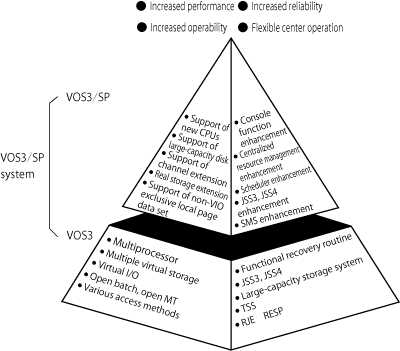VOS3/SP was an OS developed as an extension of VOS3 in order to support the ongoing enlargement of computer systems accompanied by expansion of applications such as Japanese-language capabilities and graphic processing, due to progress in hardware development. While VOS3 was free software bundled with hardware, VOS3/SP and later OSs provided functional enhancements of VOS3’s control programs as paid program products.
VOS3/SP was the generic name for the following 5 program products, which were released between March 1982 and December 1982. These products operated as additions to VOS3’s basic control programs.
|
Name
|
Release
|
Supported CPU
|
Function
|
|
VOS3/SP0
|
March 1982
|
M-180
M-200H
|
- Support for large-capacity disk
- Enhancement of centralized resource management
|
|
VOS3/SP1-JSS3
|
March 1982
|
M-180,M-200H
M-240H
M-260H
M-280H
|
- Support for large-capacity disk
- Support of channel extension
- Enhancement of console function
- Enhancement of centralized resource management
|
|
VOS3/SP1-JSS4
|
March 1982
|
|
VOS3/SP2-JSS3
|
December 1982
|
M-180
M-200H
M-240H
M-260H
M-280H
|
In addition to functions of VOS3/SP1,
- Real storage extension
- Support for non-VIO exclusive local page data set
- Enhancement of scheduler
- Enhancement of JSS3 & JSS4
- Enhancement of SMS
|
|
VOS3/SP2-JSS4
|
December 1982
|
Figure 1 shows the purposes of VOS3/SP.
 Figure 1 "Purposes of VOS3/SP"
Figure 1 "Purposes of VOS3/SP"
The OS supported new CPUs: M-280H, M-260H and M-240H.
It supported model H-8598 disk with a 1260 MB capacity, which was double the capacity of the previous large-capacity disk.
As regards channel extension, the number of channels per CPU was increased from the previous 16 to 32 for M-280H, and 24 for M-260H. This homogenized the I/O loads and increased the performance of the whole system.
Concerning centralized resource management, the OS guaranteed turnaround time and increased throughput by increasing efficiency in scheduling of system resources (CPU, real storage, I/O devices).
The OS achieved multiplicity control, in which the number of jobs to be placed on the real storage was controlled for each group of jobs (e.g., batch and TSS) divided according to job characteristics. This stabilized the load on the real storage, and the job turnaround time as a result.
The OS achieved time-slice dispatching, in which the CPU was allocated to jobs at a certain ratio. This made it possible to prevent jobs being left unexecuted, by increasing the ratio of CPU allocation for those jobs requiring short response, such as online jobs, and allocating the slight, remaining portion of the CPU to low-priority jobs.
The OS supported a function to guarantee the main storage quota so that the size of a working set of jobs fluctuated within a certain range. Because the size was not reduced to an excessive extent, the turnaround time could be guaranteed. In addition, because the size was also not increased to an excessive extent, the other jobs were not adversely affected.


